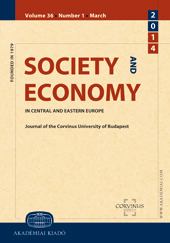Survival, growth, and performance of Hungarian International New Ventures
Survival, growth, and performance of Hungarian International New Ventures
Author(s): Miklós StockerSubject(s): National Economy, Business Economy / Management, Socio-Economic Research
Published by: Akadémiai Kiadó
Keywords: International New Ventures; survival; growth; financial performance; Hungarian companiesM130; M160; F230
Summary/Abstract: There is a growing debate in the literature about International New Ventures (INV). Survival of INVs – along with their growth and financial performance – seems to be an interesting phenomenon, but it has only been tackled in a small sample of studies. This study examines Hungarian INVs and some of their key characteristics in the years 2009–2014. The Hungarian Corporate Tax Database was used to analyse the entire population of Hungarian companies during that period. The database consists of 385,723 companies in 2009 and 422,500 companies in 2014, and comprises the whole Hungarian private sector. Of these companies, 6,547 can be identified as INVs in the period under analysis. In this paper, the survival, growth, and business performance characteristics of Hungarian INVs are examined. Hungarian INVs recorded an exceptionally high survival rate; after five business years, 70% of the INVs remained in business, but nearly half of them withdrew to the home market, which means that only 35% of the Hungarian INVs became Sustainable International New Ventures (SINVs). Hungarian SINVs employed on average about 25 employees, registered extremely high (around 75%) export intensity, had steadily growing earnings and equity (43.6% and 56.3% mean CAGR), showed a stable return on equity of about 10% after their first year in existence, and created added value of approximately 37,000 EUR per employee.
Journal: Society and Economy. In Central and Eastern Europe ǀ Journal of the Corvinus University of Budapest
- Issue Year: 41/2019
- Issue No: 1
- Page Range: 47-64
- Page Count: 18
- Language: English

